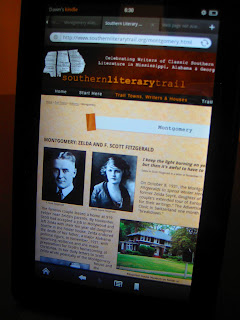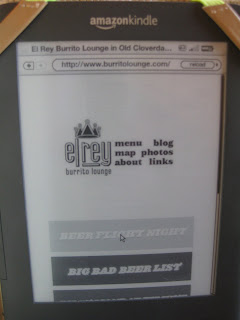 |
| Daphne Simpkins holds up her novel Cloverdale in front of Capitol Book & News, which is in the real neighborhood of Cloverdale. |
Tourism Attraction: Old Cloverdale historic district
Location: Montgomery, Alabama
Photos: Click to enlarge!
When it comes to neighborhood charm, Old Cloverdale in Montgomery, Alabama is hard to compete against. One of the historic neighborhood’s many unique charms is its independent bookstore, Capitol Book & News, where I recently met with Daphne Simpkins, the author of a new novel titled Cloverdale. The novel features the escapades of Miss Mildred Budge, a retired school teacher who finds that retirement can be as hectic and rewarding as her full time job ever was—not to mention more dangerous.
The best parts of this novel, set in the real Cloverdale, are the constant moments of subtle beauty from everyday life, like the image of a mother’s hand when giving directions. Moments like these separate this novel from a mere tour guide description and propel the reader into the spirit of the real place. Learn how to visit the real Cloverdale in the Tourism Guide and Links after these short excerpts provided from the publisher to SELTI:
From Cloverdale . . .
Kenny blinked some more, as if he didn’t recognize the name of the city where they lived. Miss Budge smiled encouragingly, and continued politely.
“I wonder if you have visited the Fitzgerald museum yet? It is to your left, about two miles that way,” Miss Budge directed, pointing, and one more time, saw her mother’s hand. She did not mind the vision of her mother’s hand extending from her arm at all. Though no one expected a woman of Miss Budge’s age to miss a parent, Mildred Budge still did miss her mother and was glad for the company of even the image of her mother’s hand.
 |
| Students read from Fitzgerald's classic works outside the F. Scott and Zelda Fitzgerald Museum in Cloverdale |
Kenny eyed the older woman as if she were speaking a foreign language. His eyes morphed to a weak shade of green. Miss Budge wondered if Kenneth was weak or just young. She had taught many young people and had learned that looking into their eyes and making assessments about intelligence or character based on an expression or shade of eye color had very little to do with who they really were—no more than how people once used to feel the bumps on a person’s cranium to determine intelligence.
Knowing that (and it had taken her a surprisingly long time to learn it) Miss Budge often fought the impulse anyway to a know person’s head shape with her fingertips, like a blind person might. Kenny had a rectangular-shaped head. Her fingers began to strum the air gently. If she could know the contours of his head with her hands, what would the arcs and bumps tell her about what was going on inside?
She clasped her hands determinedly in her lap and held them there while surreptitiously checking the closure of her robe. Her mother would have liked this robe, too, she thought—and smiled.
“The museum is the old house of a famous Montgomery family. F. Scott Fitzgerald is a famous author. He married a Montgomery girl,” she explained patiently. “You may recall from your high school days that Fitzgerald wrote The Great Gatsby.”
 |
| Cloverdale home. Photo by Old Cloverdale Association |
Kenny stared at Miss Budge blankly, and the color of his eyes deepened to the color of an ocean just before it rained. Troubled, Kenny tried to figure out what to say next. When he didn’t immediately speak, Miss Budge continued.
“His wife Zelda Sayre was not only a famous southern belle here but a talented writer as well.” Kenny’s fingertips scratched the tops of his thighs as if he were getting ready to explain the purpose of his visit. Miss Budge nodded encouragingly, but Kenny did not respond to her cue. “Or, there’s Martin Luther King, Jr.’s church downtown or The First White House of the Confederacy,” she added, sounding like one of those volunteer tour guides that some senior citizens become to fill their days after they retired. Though she was retired—prematurely, according to some—she was still too busy to volunteer in that capacity.
(Later in the story . . .)
 |
| A tour bus stops in one of several scenic parks in Cloverdale |
She was glad of the memories that rose up in her. Glad of the fragrance of new grass and cool mint and tea olive. Glad that the day had grown warmer and that the next day promised to be warmer still. Soon, there would be honeysuckle and gardenias, and better, the smell of tomatoes growing luxuriously on vines in the yards. People plucked them like apples and sometimes ate them the same way. Juicy. Dripping. Tasting like sunshine.
“God be praised,” Mildred moaned in gratitude for the hope of tomatoes and the presence of the unexpected gift of solitude.
 |
| Lampost. Photo by Old Cloverdale Association |
The solar street lights began to pulse toward beaming, lighting her path through Cloverdale, and she felt as if some part of her interior self was waking up in the same way. Each step seemed to give rise to a refreshed wakefulness. The neighborhood houses, built in a time when people wanted big yards, were mostly set back deeply on wide lots where old gardens and ancient trees had taken over.
There was an occasional cottage that had previously been a carriage house—a place where once, long ago, in a different South the servants had lived. These smaller homes were like her own bungalow, intimate and warm and inviting with their well tended coziness. Mildred loved the variety of houses and old southern yards in Cloverdale as much as she recoiled from the cookie-cutter designs of planned communities that had been developed by real estate people around the heart of the city. On the periphery of Cloverdale were other neighborhoods with assigned names meant to establish atmosphere but did not achieve the other purpose of creating the character of the neighborhood.
 |
| Cloverdale hedges. Photo by Old Cloverdale Association |
Miss Budge preferred unsculptured bushes and casually kept hedges to mark loose boundaries. They fit the landscape of her mind better.
---Excerpted with permission from CLOVERDALE, Copyright © 2011 by Diane Simpkins.
TOURISM GUIDE
 |
| Photo by Old Cloverdale Association |
Blind Fate and Dixie Noir were recently featured in USA Today for their innovation of interactive tourism guides inside the Kindle novels. The USA Today feature article included one of our photos from inside the Fitzgerald Museum. I first discovered author Bart Barton and his novel The Cross Garden while reading an article about his book signing at Capitol Book & News. I met with Bart at the real El Rey to prepare for his tourism profile. Finally, the Fitzgerald House was the setting for the SELTI article What Would Fitzgerald Think of the Kindle? So naturally, when a novel titled Cloverdale came out, I had to connect with the author.
There are so many connections to this neighborhood now that I am officially establishing Cloverdale as the epicenter of the new wave of national tourism fiction. There is something very special about this area. Aside from the beautiful homes and parks, there are many wonderful shops and restaurants that invite the tourist to stay a while and experience a quality of life not found anywhere else in the city. Browse the links below to learn more about this area and the surrounding tourism attractions of Montgomery. If you enjoy Cloverdale, you might also want to read the anthology of short stories that introduce the main character, Miss Budge in Love, available in paperback and also on Kindle for 99¢.
TOURISM LINKS
Click on links above in the text to visit the websites of the real places. In addition, click on the links below related to the novel and the surrounding area.
Daphne Simpkins' website/ order the book
Old Cloverdale Association: wonderful tourist guide to Old Cloverdale
Capitol Book & News
Comfort Publishing: publisher of Cloverdale
El Rey Lounge: great place to eat!
F. Scott and Zelda Fitzgerald Museum
Montgomery attractions outside of Cloverdale
Hank Williams Museum
City of Montgomery tourism website
Alabama Tourism Department
Rosa Parks Museum
First White House of the Confederacy
Alabama Shakespeare Festival
Montgomery Museum of Fine Arts
DECEMBER CONNECTIONS
If you enjoy Cloverdale, then you will enjoy the previous December SELTI features from 2010 and 2009.
The short story "Ohme," featuring a grandmother in a real South Carolina town on Christmas day.
 |
| Pendleton, SC, the setting of "Ohme" Murder in Dollywood Country! Read an excerpt from Fifty-Seven Traveling, a novel about a grandmother sleuth on vacation in Pigeon Forge, TN |






































